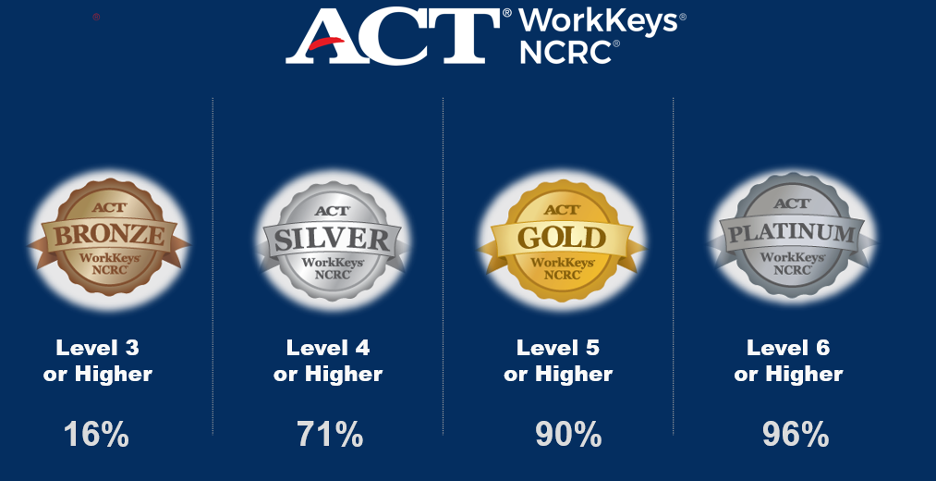What Are ACT WorkKeys Assessments, and Why Should Your Child Take Them?

WorkKeys is a system of foundational skills assessments that ACT developed in the 1990s to help businesses match the skills of current or potential employees to the requirements of positions. As part of the Kansans Can vision for the future of public education in our state, the Kansas Legislature appropriated funds to provide one free WorkKeys suite of assessments to all public high school juniors.
Many parents, students and educators are familiar with the ACT test, which is designed to predict college readiness, but they are unfamiliar with the WorkKeys assessment. I hope this blog will help you and your child decide if your child should take advantage of this free assessment during their junior year.
What Are ACT WorkKeys Assessments?
WorkKeys assessments measure foundational skills required for success in the workplace and they help measure the skills that can affect job performance. WorkKeys assessments are:
- Relevant: WorkKeys assessments are developed to solve actual workplace problems. Unlike other assessments, they don’t simply give an indication of reading and writing competency. Instead, they measure a range of hard and soft skills relevant to any occupation, at any level, and across industries.
- Recognized: Successful completion of WorkKeys core assessments can lead to earning an ACT WorkKeys National Career Readiness Certificate (NCRC) — a credential that verifies the skills found to be most essential across industries and occupations.
What Is the National Career Readiness Certificate?
High school students are tested in the three core assessments of the ACT WorkKeys exam to earn the NCRC. Those core assessments are:
- Applied Math. Measures critical thinking, mathematical reasoning and problem-solving techniques for situations that actually occur in today’s workplace. While students can use calculators and conversion tables to help with the problems on the assessment, math skills are still needed to think them through.
- Graphic Literacy. Measures the skills needed to locate, synthesize and use information from workplace graphics. In today’s world, data comes in a variety of formats. From charts to graphs, diagrams to floor plans, identifying what information is being presented and understanding how to use it are critical to success.
- Workplace Documents. Measures the skills people need when they read and use written texts such as memos, letters, directions, signs, notices, bulletins, policies and regulations on the job. Employees need to be able to understand written texts to do a job.
Students who score a 3 or higher on each assessment earn the NCRC, which is valuable documentation of their skills. Certificate levels are bronze (scores of 3), silver (4), gold (5) or platinum (6+). The highest score is 7. An NCRC will give your child a nationally recognized credential that is portable and evidence based, one that validates their work readiness skills. For more information about the exams and the NCRC, you can read more here.

How Can Students Apply Their Scores to Learn about Their Strengths?
Once your child receives their scores, they can use them to explore and/or confirm career areas of interest that are a good match for their skills. One helpful resource is the ACT Job Profiles. Students can use the dropdown “search by skills” tab to enter their WorkKeys scores and then explore careers. If your child isn’t sure about what career field they want to pursue, this is a great starting point to begin their research, starting with jobs that match their natural skills. If a student has a career field in mind, he or she can search that career and see the scores profiled for success.
Another valuable resource to easily research careers and WorkKeys scores can be found here. This Career Readiness tool gives a quick overview of job outlooks, educational requirements and projected income. Since your child will take the WorkKeys exam while in high school, they still have time to develop their skills and gain work experience. Your child’s WorkKeys scores, demonstrated skills and NCRC documentation can become valuable tools when they’re ready to start looking for jobs.
How Do WorkKeys Scores Benefit Students as They Prepare to Enter the Workforce?
The WorkKeys assessment can be a big part of your child’s high school individual plan of study (IPS) portfolio and provide many benefits:
- An NCRC is a national credential that can be used wherever your child might move within the United States.
- An NCRC can be included in a portfolio as a credential verifying transferable job skills.
- Skills listed on the NCRC can be used to develop a resume with meaningful job skills rather than listing arbitrary or generic skills. For example, “Infer the meaning of an acronym, jargon or technical term from context” (Workplace Documents assessment); “Interpret a trend/pattern/relationship” (Graphic Literacy assessment); or “Set up and manipulate ratios, rates or proportions where at least one of the quantities is a fraction” (Applied Math assessment). The specific skills demonstrated are listed on the back of the student’s NCRC.
- Scores can be used for career research. This research should be included in the portfolio as part of a student’s education and career planning, which can inform a student’s career/education path.
- Scores can be used as a baseline tool to set realistic goals in partnership with a teacher or job mentor. Students must be aware of their strengths and areas needing improvement to make this process meaningful.
- Knowing your WorkKeys score helps employers identify qualified applicants. Some employers may practice preferential hiring for job seekers who have earned an NCRC.
- When interviewing, students draw upon what they learned through the WorkKeys assessment to speak clearly and efficiently about their specific skills and how those can add value to a company.
-
Students can share their NCRC badge with anyone they like: LinkedIn, Facebook, Twitter, email, on a resume, or embedded in a website. For students who have earned a Platinum, Gold, or Silver badge earner, they can also obtain up to 6 hours of college credits through digitally sharing their transcript with accepting institutions. A viewer can click on a digital NCRC badge and will be taken back to Credly to view all the details of a student’s achievement. Upon earning the WorkKeys NCRC, students will receive an email from Credly to accept their digital badge.
In addition, testing high school students as part of the emerging workforce can benefit local economic development efforts. Counties can become Certified Work Ready Communities based on their testing practices. This can improve economic growth and competitiveness by demonstrating the presence of a skilled workforce, which can bring a wider variety of jobs and higher-paying jobs to the community.
If your child (or you yourself!) would like to retest or test for WorkKeys, check with a school counselor, local workforce center or search for a testing site here.




